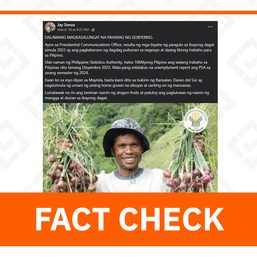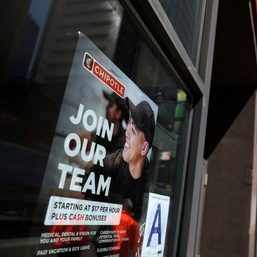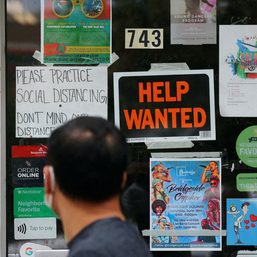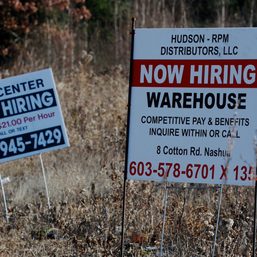SUMMARY
This is AI generated summarization, which may have errors. For context, always refer to the full article.
![[ANALYSIS] Joblessness, prices soar, yet Duterte’s aid still missing](https://www.rappler.com/tachyon/2021/06/unemployment-TL-SQ.jpg)
The Philippines is languishing on two fronts: health and the economy.
For one, new COVID-19 cases seem to have settled between 6,000 to 7,000 a day. Last year, such numbers would have scared most of us and prompted strict lockdowns. But we seem to have been desensitized of late. Is this part of “living with the virus”?
Meanwhile, government statisticians disclosed that the Philippine unemployment rate climbed back to 8.7% in April 2021, owing largely to the recent reinstatement of lockdown measures. That’s higher than March’s 7.1% and translates to more than 4 million unemployed Filipinos – just like in February.
Worse, the inflation rate, which measures how fast prices are rising, also stayed at 4.5% in May, its 3rd consecutive month at that level – and firmly above the government’s 4% upper target.
Soaring unemployment and inflation spell economic misery for millions of Filipinos. Despite this, the Duterte government is not providing enough economic aid or significantly accelerating vaccination, both of which are key to our economy’s recovery.
Unless government gets its act together soon, the economic crisis will linger painfully.
Double whammy
Figure 1 shows the small glimmer of hope in March when the unemployment rate dropped to 7.1%, equivalent to 3.44 million people. By pandemic standards, that’s already a win of sorts.
But that was quickly reversed by the reimposition of strict quarantine measures in Metro Manila and nearby provinces in late March and until mid-May, prompted by the steep rise of COVID-19 cases.
It came as no surprise that the number of jobless Filipinos rose again in April. In fact it was still 73% higher than its pre-pandemic level, or in January 2020 (meanwhile, the number of employed Filipinos was a mere 1.71% higher).
<iframe title=”No. of unemployed still 73% above pre-pandemic level” aria-label=”Interactive line chart” id=”datawrapper-chart-BZ34l” src=”https://datawrapper.dwcdn.net/BZ34l/1/” scrolling=”no” frameborder=”0″ style=”width: 0; min-width: 100% !important; border: none;” height=”400″></iframe><script type=”text/javascript”>!function(){“use strict”;window.addEventListener(“message”,(function(e){if(void 0!==e.data[“datawrapper-height”]){var t=document.querySelectorAll(“iframe”);for(var a in e.data[“datawrapper-height”])for(var r=0;r<t.length;r++){if(t[r].contentWindow===e.source)t[r].style.height=e.data[“datawrapper-height”][a]+”px”}}}))}();
</script>
Figure 1
Propagandists tried to spin this by, say, posting on social media that “PH posts lower unemployment rate at 8.7% in April.” But comparing the jobs numbers against the nadir in April 2020 is misleading and masks the economy’s shaky recovery, which rests on a misguided trade-off between public health and the economy. (READ: Debunking the deadly lies of Duterte’s economic managers)
Sure, some sectors of the workforce are now getting back on their feet as the economy gingerly reopens. But those in hotels, restaurants, arts/entertainment/recreation, tourism, and transportation/storage are still stuck in a rut.
High unemployment typically comes with low inflation or a slow increase of prices. This makes intuitive sense: with anemic economic activity, there’s little pressure for firms to set higher prices on their goods and services.
Yet exactly the opposite has happened. Inflation has abnormally risen, mainly driven by the sharp and continued rise of pork prices. In May, more than three-fourths of the increase in food prices was due to meat alone (Figure 2).
<iframe title=”Meat stoked food inflation the most” aria-label=”Interactive line chart” id=”datawrapper-chart-H0KbQ” src=”https://datawrapper.dwcdn.net/H0KbQ/9/” scrolling=”no” frameborder=”0″ style=”width: 0; min-width: 100% !important; border: none;” height=”400″></iframe><script type=”text/javascript”>!function(){“use strict”;window.addEventListener(“message”,(function(e){if(void 0!==e.data[“datawrapper-height”]){var t=document.querySelectorAll(“iframe”);for(var a in e.data[“datawrapper-height”])for(var r=0;r<t.length;r++){if(t[r].contentWindow===e.source)t[r].style.height=e.data[“datawrapper-height”][a]+”px”}}}))}();
</script>
Figure 2
The reason of course is the very short supply of pigs, which has been decimated by the other pandemic that is African swine fever. Although government capped pork prices early this year and lowered trade barriers to allow greater importation, pork prices remain high. (READ: Why Duterte’s pork price ceilings backfired)
In the meantime, people have shunned pork in favor of alternatives like chicken and fish, but this has only stoked inflation further.
Why is Duterte scrimping on aid?
In sum, millions of Filipinos remain jobless, and the little income they have left can buy fewer goods and services.
This is perhaps why some economists interpret unemployment plus inflation as a crude measure of “economic misery.” (There are more advanced ways of doing this, but for now we’ll settle with simply adding unemployment and inflation.)
Figure 3 shows that in 2018 economic misery rose chiefly because of accelerating prices. But this pales in comparison to the skyrocketing of economic misery during the pandemic, largely owing to the record 18% unemployment rate in April 2020.
Today, economic misery has plateaued at a high level because of the double whammy of high unemployment and high inflation.
<iframe title=”Economic misery has reached record highs” aria-label=”Interactive line chart” id=”datawrapper-chart-XHA9h” src=”https://datawrapper.dwcdn.net/XHA9h/1/” scrolling=”no” frameborder=”0″ style=”width: 0; min-width: 100% !important; border: none;” height=”400″></iframe><script type=”text/javascript”>!function(){“use strict”;window.addEventListener(“message”,(function(e){if(void 0!==e.data[“datawrapper-height”]){var t=document.querySelectorAll(“iframe”);for(var a in e.data[“datawrapper-height”])for(var r=0;r<t.length;r++){if(t[r].contentWindow===e.source)t[r].style.height=e.data[“datawrapper-height”][a]+”px”}}}))}();
</script>
Figure 3
Clearly, the severe lack of jobs and the erosion of people’s purchasing power strongly justify public clamor for massive economic aid.
Although the House of Representatives already passed on final reading the economic relief package called Bayanihan 3 – it’s just a little over P400 billion – lawmakers inserted in it P54.6 billion in military and police pensions, and it still has quite a way to go in the legislative mill. (READ: Military, police pensions in Bayanihan 3? But why?)
The fault lies not just with Congress but with the executive, too. Duterte’s economic managers are still refusing to put their weight behind Bayanihan 3 (feebly arguing that we should focus on spending the balance of the 2020 budget and Bayanihan 2). And Duterte himself hasn’t yet certified Bayanihan 3 as urgent.
The snail’s pace of Bayanihan 3 has led some people to think that perhaps government is waiting to pour economic aid in the run-up to the 2022 elections, so they can win brownie points from the electorate.
But Filipinos are losing their jobs and suffering high prices now. The fact that government is currently leaving millions of Filipinos in the lurch – just when they need aid the most – ought to be a major campaign issue next year.
Too few jabs, too
Rather than hand out tons of economic aid, Duterte and his minions seem to be putting all their hopes in the vaccination effort. But even here they’re failing miserably.
To inoculate more people, government recently started vaccinating “economic frontliners.” But the dire shortage of vaccines worldwide is proving to be the biggest constraint now. (READ: The economics of vaccinating 70 million Filipinos)
On June 10, the Philippines received its biggest delivery of vaccines yet: 2.27 million doses from Covax. While this might help abate vaccine hesitancy to some degree, it’s still not nearly enough to achieve herd immunity by year-end, as originally planned. At the current rate, we won’t likely reach herd immunity until 2023.
Thankfully, more doses are coming. Vaccine manufacturers worldwide are ramping up production, and more rich countries are subsidizing vaccines for poor countries. On June 10, US President Joe Biden declared that his government will purchase half a billion vaccines to be shipped out to developing countries starting August this year.
The real aim, though, is to get those doses into as many Filipino’s arms as possible, and fast. The economy’s full recovery hinges on this.
In their final year in office, will the Duterte government rise to the challenge? Or will we all have to wait for the next administration for change to come? – Rappler.com
JC Punongbayan is a PhD candidate and teaching fellow at the UP School of Economics. His views are independent of the views of his affiliations. Follow JC on Twitter (@jcpunongbayan) and Usapang Econ (usapangecon.com).
Add a comment
How does this make you feel?
![[ANALYSIS] A new advocacy in race to financial literacy](https://www.rappler.com/tachyon/2024/04/advocacy-race-financial-literacy-April-19-2024.jpg?resize=257%2C257&crop_strategy=attention)


![[In This Economy] Can the PH become an upper-middle income country within this lifetime?](https://www.rappler.com/tachyon/2024/04/tl-ph-upper-income-country-04052024.jpg?resize=257%2C257&crop=295px%2C0px%2C720px%2C720px)






There are no comments yet. Add your comment to start the conversation.